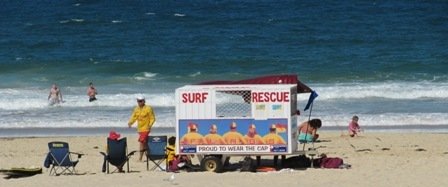Aussie Beaches - everyone should visit at least one in their lifetime!
Beach Safety
IMPORTANT:- FOR MEDICAL EMERGENCY - CONTACT NO: IN AUSTRALIA IS 000
Beach Safety should be everyone's concern and responsibility so that a
day at an Australian Beach does not have to end in tragedy, even though
Australia is home to some of the world’s most Dangerous Sea Life
Common sense and safety go hand in hand with the Australian Beach - whether your choice is a small secluded beach with no lifeguards or one of our major beaches that have flags and lifeguards.
For those beaches that are patrolled by LIFEGUARDS,

- please always remember they are there to help you – it’s the Aussie thing to do – when someone is in trouble you can always rely on an Aussie – we love our beaches and we want you to love them too.
So be beach smart and listen to the experts when it comes to Beach Safety and if your new to the Aussie Beach – don't be scared and always ask questions – you might be surprised by what you hear.
The Do’s & Don’t’s of Beach Safety
DO's
- Swim between the flags – it’s the safest area on the beach to swim and has been determined by professionals
- Observe the safety signs – they are there for “your protection”
- When unsure – ask a lifeguard – they won’t misinform – their passion is your enjoyment and safety
- Go with a friend – there is safety in numbers, children should always have adult supervision
- If you get into trouble – stick your arm up – (this is the help signal for beach swimmers), go with the current to preserve energy
DONT'S
- Don’t swim at night – you won’t be able to see what’s in the water
- Don’t swim when drunk – it lowers your response times
- Don’t run and dive into the water – spinal damage can be permanent
Beach Safety at Surf Beaches
Rips are the most common cause of rescues at surf beaches and by recognizing this and the conditions that create a rip will increase your safety for every visit you make to our beaches
Websters Definition: - A Rip is:-an extent of rough, broken water caused as by the meeting of cross currents or tides or the interaction of currents and wind
And when this occurs there is a high danger for those in the surf to be carried out to deeper water in a very short time frame, and unable to get back to the shore if they are fighting against the rip. Your best defence is knowledge, starting with identifying if a rip is present, and anyone can do this by:-
- Part of the water being a darker colour – which shows the water is deeper at that point
- Colour of the water is murky brown – sand is being moved around from the bottom of the sea
- Smoother surface with smaller waves adjacent to broken waves
- Waves breaking in the distance on either side of the rip
- Rubbish floating out to sea
- The water having a rippled look, surrounded by calm water
And now that you have the knowledge to recognise a rip, you might also find it handy to know what to do if you are unfortunate to be caught in a rip:-
- First and foremost – DO NOT PANIC – STAY CALM
- Float with the current, raise your arm for assistance – if a strong swimmer – swim parallel to the shore, once you reach the break zone (where the waves peak, break and release), attempt to swim back to shore
- If not a strong swimmer, float with rip, ensuring that you have raised your arm for assistance
- Conserve your energy as over exertion can lead to panic, which becomes a catch 22 situation – the more you panic, the more energy you use, the harder the rescue.
Again - don't forget - BEACH SAFETY - is everyone's responsibility!
Thanks go to Australian Lifeguard Services for information for Safety at the Beach and I recommend for further information that you access their site.
